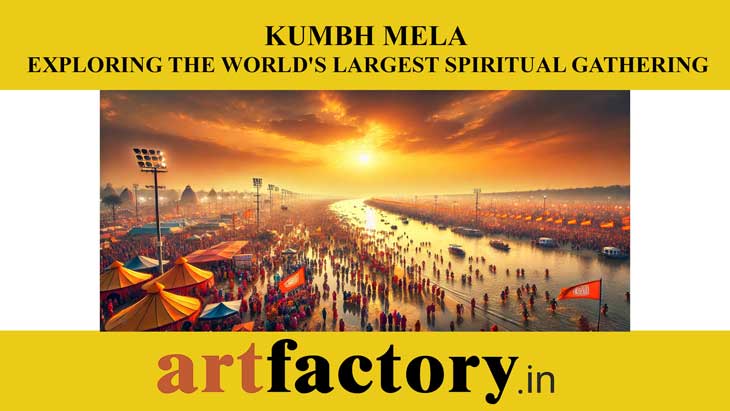
Kumbh Mela: Exploring the World's Largest Spiritual Gathering
Introduction
Kumbh Mela is one of the largest religious gatherings in the world, celebrated with unparalleled fervor and devotion in India. It transcends the boundaries of religion to become a cultural and spiritual phenomenon. Held once every 12 years at four locations—Prayagraj, Haridwar, Ujjain, and Nashik—this event attracts millions of devotees, saints, and seekers from around the globe. But what makes Kumbh Mela so significant? Let’s explore its origins, spiritual essence, and modern-day relevance.
Origins of Kumbh Mela
The Kumbh Mela has its roots in ancient Hindu mythology, particularly the story of the Samudra Manthan (Churning of the Ocean):
- According to the Puranas, during the churning of the ocean by the Devas (gods) and Asuras (demons) for the nectar of immortality (Amrit), four drops of this nectar spilled on earth at Prayagraj, Haridwar, Nashik, and Ujjain.
- These locations became spiritually charged, and bathing in the sacred rivers at these sites during Kumbh Mela is believed to cleanse sins and grant liberation (Moksha).
Why Kumbh Mela is Held
The Kumbh Mela is held as a celebration of this divine event and is timed based on the positioning of planets and constellations:
Astrological Significance: The timing of Kumbh Mela is determined by the alignment of the Sun, Moon, and Jupiter. For instance:
- Haridwar: When Jupiter is in Aquarius and the Sun is in Aries.
- Prayagraj: When Jupiter is in Taurus and the Sun is in Capricorn.
These celestial configurations are considered highly auspicious, amplifying the spiritual benefits of taking a holy dip.
Significance of Kumbh Mela
Spiritual Cleansing
Bathing in the rivers during Kumbh Mela, especially the Ganga, Yamuna, and the mythical Saraswati at Prayagraj, is believed to wash away sins and pave the path to Moksha. This ritual attracts millions who seek purification and renewal.Confluence of Faith and Unity
Kumbh Mela brings together people from all walks of life—ascetics, pilgrims, scholars, and tourists—creating an unparalleled sense of collective devotion. It is a melting pot of spirituality, culture, and knowledge.Platform for Spiritual Knowledge
The Mela serves as a meeting ground for saints and sages to share wisdom. Discourses, satsangs, and rituals inspire spiritual seekers and guide them on the path of self-realization.Cultural and Historical Legacy
Kumbh Mela is a repository of India’s ancient traditions, art forms, and philosophies. It has been recognized by UNESCO as an Intangible Cultural Heritage, showcasing the country’s rich heritage on a global stage.Reaffirming Faith in Humanity
The sheer magnitude of the event demonstrates the resilience, discipline, and faith of millions coming together in harmony. It reaffirms the belief in the power of unity and devotion.
Modern Relevance
A Global Spiritual Hub
Kumbh Mela has evolved into an international event, attracting global attention and participation. It highlights India as a center for spirituality and culture.Environmental Awareness
The festival also serves as a reminder of the importance of rivers in sustaining life. Campaigns during the event often promote water conservation and pollution control.Economic Impact
From tourism to local businesses, the Kumbh Mela generates significant economic activity, benefiting millions of livelihoods.
Conclusion
Kumbh Mela is more than a religious gathering—it is a celebration of faith, spirituality, and humanity. Rooted in ancient mythology and enriched by centuries of tradition, it offers an opportunity for individuals to reconnect with their inner selves, their cultural heritage, and the divine. In an increasingly chaotic world, the Kumbh Mela stands as a beacon of hope, unity, and transcendence.
Let us honor this timeless festival and its profound message of spiritual rejuvenation and universal harmony.
Questions and Answers for SEO
What is Kumbh Mela?
Kumbh Mela is one of the largest spiritual gatherings in the world, celebrated every 12 years at four sacred locations in India: Prayagraj, Haridwar, Ujjain, and Nashik.Why is Kumbh Mela celebrated?
Kumbh Mela is celebrated to commemorate the divine event where drops of nectar fell on Earth during the churning of the ocean, making these sites spiritually charged.What is the significance of bathing in Kumbh Mela?
Bathing in the sacred rivers during Kumbh Mela is believed to cleanse sins and help attain liberation (Moksha).Where is Kumbh Mela held?
Kumbh Mela is held at Prayagraj, Haridwar, Nashik, and Ujjain, rotating every 12 years based on astrological alignments.What is the mythological story behind Kumbh Mela?
The festival is rooted in the Samudra Manthan, the churning of the ocean by gods and demons for Amrit (nectar), with four drops falling at the Kumbh Mela locations.How often does Kumbh Mela occur?
Kumbh Mela is held every 12 years at each location, with smaller Ardh Kumbh and Maha Kumbh festivals occurring in between.Why is Kumbh Mela significant in Hinduism?
It is a spiritual gathering where millions seek purification, divine blessings, and spiritual enlightenment through rituals and discourses.How does astrology determine Kumbh Mela dates?
The dates are based on the alignment of Jupiter, the Sun, and the Moon in specific zodiac signs.Is Kumbh Mela recognized globally?
Yes, Kumbh Mela is recognized by UNESCO as an Intangible Cultural Heritage of Humanity.
For more details,visit:https://artfactory.in/

Comments : (0)